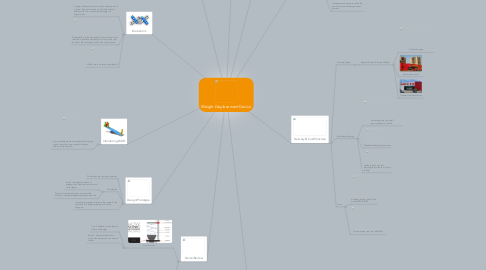
1. Differentiation
1.1. Why am I unique?
1.1.1. Can be used to make any transportation device more efficient.
1.2. Effectiveness?
1.2.1. Reduces the weight of an object up to 70%
2. The Problem
2.1. Since the market for consuming goods is continually expanding. We need to find more efficient means of transporting goods.
2.2. With our limited reserves of fossil fuel and oils will we need to find different fuel alternatives or find a more effective way of transporting.
3. Brainstorm
3.1. Finding different fuel sources like nuclear power is a good idea, however we would likely need to adapt more of our current technologies to support that.
3.2. Teleportation is the best solution, however it will not likely be a possible proposal as it may pose a real danger if the technology falls to the wrong hands.
3.3. What if we can make things lighter?
4. Introducing WDD
4.1. It is a portable device that reduces the weight of any object by using acoustic levitation within a certain radius.
5. Design/Prototype
5.1. Portable as well as larger versions
5.2. Two Modes
5.2.1. First is to detect the resonant frequencies of the items we want to make lighter
5.2.2. Second is that we have the user select the amount of weight displacement they would like.
5.3. Has safety measures to ensure the matter in the vehicle that is being displaced will not be changed
6. Demo/Review
6.1. How it works ^
6.1.1. First, Calibrate to the object to reduce the weight
6.1.2. Second, Adjustment button to control the weight the user want to reduce
6.2. What it will look like ^
7. Impact of Triple Bottom Line
7.1. People
7.1.1. Save people money on transportation
7.1.2. Can help those who have mobility problems
7.2. Profit
7.2.1. Saves a whole bunch of fuel
7.2.2. Can help structural integrity for certain capital
7.3. Planet
7.3.1. Reduces gas emissions and greenhouse gases
7.3.2. Slowing down our use of non reusable fuels till we find a better fuel source
8. Marketing Groups
8.1. Consumers with vehicles
8.2. Businesses looking to make tansportation more effiecent
8.3. Governments wanting to utilize this device for national transportation services
9. Alliances
9.1. Partners
9.1.1. Environmental Companies or Charities
9.1.2. Ex: GreenPeace, Environmental Working Group
9.2. Cooperation with Other Institutions
9.2.1. Federal Government
9.2.1.1. FAA (Federal Aviation Administration )
9.2.1.2. TSB (Transportation and Safety Board of Canada)
9.2.2. Air line Services
9.2.2.1. Air Canada
9.2.3. Railway Services
9.2.3.1. VIA Rail
10. Delivery & Cost Structure
10.1. Delivery System
10.1.1. Regular Product Delivery Method
10.1.1.1. Online shopping
10.1.1.2. Automotive stores
10.1.1.3. General Hardware Stores
10.2. Marketing Strategy
10.2.1. Something you can install permanently in a vehicle.
10.2.2. Portable battery power versions
10.2.3. Lobby to pass as a law requiring to use these on every vehicle
10.3. Cost
10.3.1. Average cost per unit will be around $80 to $200
10.3.2. Profit margins vary from 40%-50%
